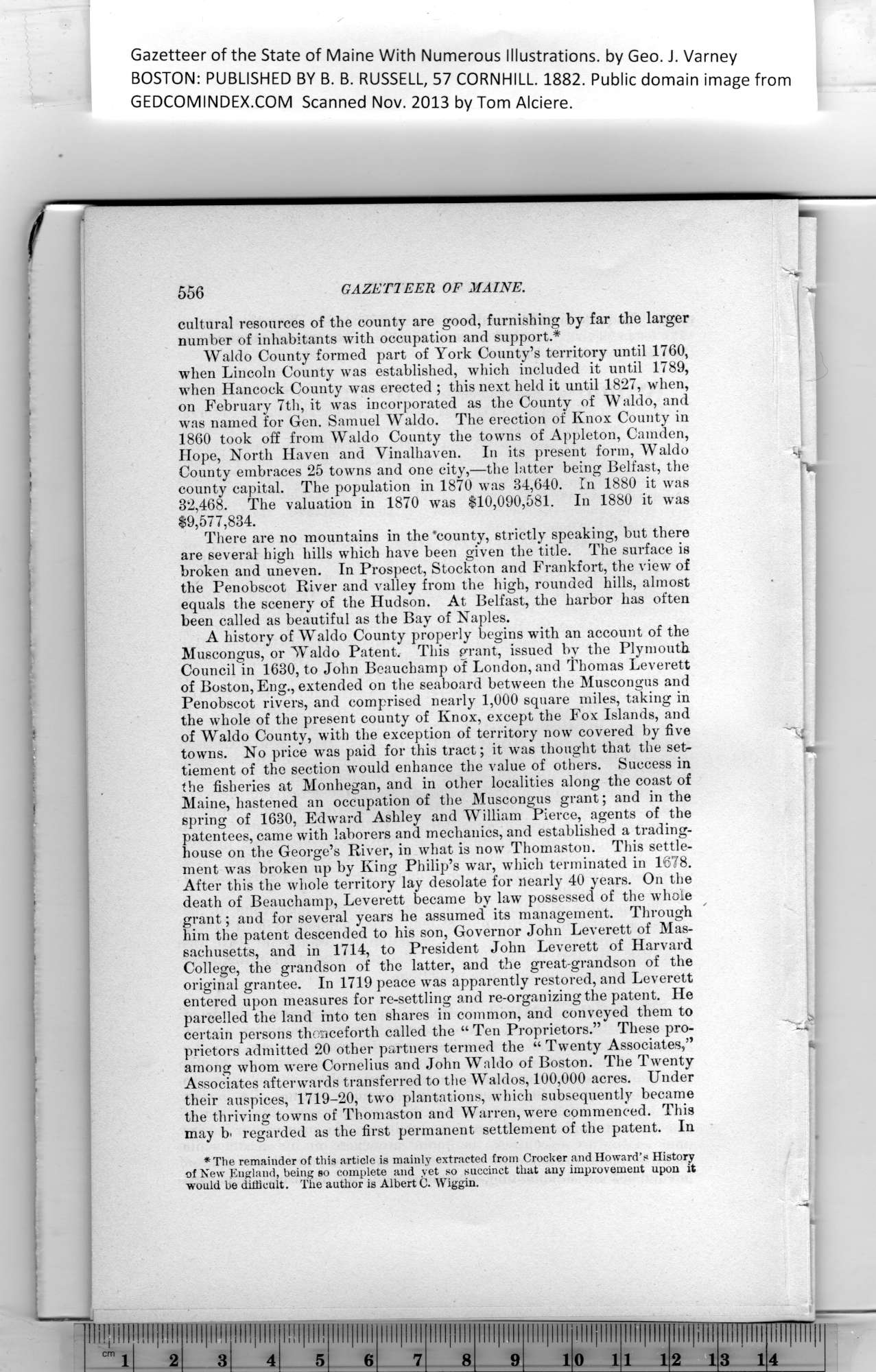|
Gazetteer of the State of Maine With Numerous Illustrations, by Geo. J. Varney
BOSTON. PUBLISHED BY B. B. RUSSELL, 57 CORNHILL. 1882. Public domain image from
556 GAZET2 EER OF MAINE.
cultural resources of the county are good, furnishing by far the larger
number of inhabitants with occupation and support.1
Waldo County formed part of York County’s territory until 1760,
when Lincoln County was established, which included it until 1789,
when Hancock County was erected ; this next held it until 18*27, when,
on February 7th, it was incorporated as the County of Waldo, and
was named for Gen. Samuel Waldo. The erection of Knox County in
1860 took off from Waldo County the towns of Appleton, Camden,
Hope, North Haven and Vinalhaven. In its present form, Waldo
County embraces 25 towns and one city,—the latter being Belfast, the
county capital. The population in 1870 was 34,640. In 1880 it was
32,468. The valuation in 1870 was $10,090,581. In 1880 it was
$9,577,834.
There are no mountains in the ‘county, 6trictly speaking, but there
are several high hills which have been given the title. The surface is
broken and uneven. In Prospect, Stockton and Frankfort, the view of
the Penobscot River and valley from the high, rounded hills, almost
equals the scenery of the Hudson. At Belfast, the harbor lias often
been called as beautiful as the Bay of Naples.
A history of Waldo County properly begins with an account of the
Muscongus, or Waldo Patent. This grant, issued by the Plymouth
Council in 1630, to John Beauchamp of London, and Thomas Leverett
of Boston, Eng., extended on the seaboard between the Muscongus and
Penobscot rivers, and comprised nearly 1,000 square miles, taking in
the whole of the present county of Knox, except the Fox Islands, and
of Waldo County, with the exception of territory now covered by five
towns. No price wras paid for this tract; it was thought that the set-
tlement of the section would enhance the value of others. Success in
the fisheries at Monhegan, and in other localities along the coast of
Maine, hastened an occupation of the Muscongus grant; and in the
spring of 1630, Edward Ashley and William Pierce, agents of the
patentees, came with laborers and mechanics, and established a trading-
house on the George’s River, in what is now Thomaston. This settle-
ment was broken up by King Philip’s war, which terminated in 1678.
After this the whole territory lay desolate for nearly 40 years. On the
death of Beauchamp, Leverett became by law possessed of the whole
grant; and for several years he assumed.' its management. Through
him the patent descended to his son, Governor John Leverett of Mas-
sachusetts, and in 1714, to President John Leverett of Harvard
College, the grandson of the latter, and the great-grandson of the
original grantee. In 1719 peace was apparently restored, and Leverett
entered upon measures for re-settling and re-organizing the patent. He
parcelled the land into ten shares in common, and conveyed them to
certain persons thenceforth called the “Ten Proprietors.” These pro-
prietors admitted 20 other partners termed the “ Twenty Associates,” i.
among whom were Cornelius and John Waldo of Boston. The Twenty
Associates afterwards transferred to the Waldos, 100,000 acres. Under
their auspices, 1719-20, two plantations, which subsequently became
the thriving towns of Thomaston and Warren, were commenced. This
may b> regarded as the first permanent settlement of the patent. In
1
The remainder of this article is mainly extracted from Crocker and Howard’s History
of New Euglaud, being so complete and yet so succinct that any improvement upon it
would be difficult. The author is Albert C. Wiggin.
PREVIOUS PAGE ... NEXT PAGE
This page was written in HTML using a program written in Python 3.2
|
